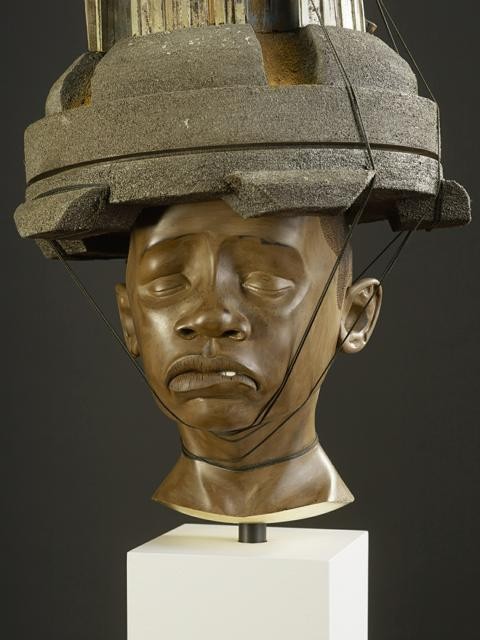The Center for Craft, Creativity & Design christened its new space at 67 Broadway St. with an opening reception and inaugural exhibition, Taking Shape: Celebrating the Windgate Fellowship. The center’s Friday, Jan. 24, launch was a bit of a triumph over adversity. It followed a 2013 budget cut-turned-institutional severance from UNC Asheville, a relocation from Hendersonville, the recent purchase of the downtown Asheville building (which formerly housed Lark Books) and four months of renovations.
The Taking Shape exhibit, on display through May 3 in the center’s Benchspace Gallery & Workshop, was curated by Cindi Strauss of The Museum of Fine Arts in Houston. Asheville is the second stop for the collection, which premiered at SOFA Chicago in October and heads next to Houston Center for Contemporary Craft.
“Taking Shape is a way to introduce the work that the center does to Asheville,” says Marilyn Zapf, the center’s assistant director. But the exhibition also serves as an exploratory definition of the center’s evolving role in the national craft community. “We could achieve our mission anywhere in the U.S.,” Stephanie Moore, the center’s executive director, says. But the region’s rich history and culture in craft make the center’s locale ideal, turning the new space into an incubator supported by an avid craft community.
“We have the opportunity to show craft in an environment that shifts the focus to a critical dialogue,” Zapf says, “and to survey the thought and the medium and the process.” That dialogue is largely centered on one common question: What is craft?
The exhibit features new works by past recipients of the annual Windgate Fellowship, one of the nonprofit organization’s flagship programs. Each year since 2006 the center, in partnership with the Arkansas-based Windgate Charitable Foundation, awards 10 $15,000 grants to graduating college seniors working in the field of craft and design. That program, according to Moore, fills the “critical need of funding undergraduates at a time when most funds [are] directed to graduate level students.”
The fellowship program is entering its eighth year, though Taking Shape surveys only the first five years. “We’re far enough into the internship that we can study the impact of the grants,” says Zapf. The works on display encompass traditional modes of craft, conceptually derived modern pieces and everything in between. Handwoven and pigmented textiles share space with tintype photographs and a redesigned rocking chair.
In “Fragment #3 (Roses are Red)” Aaron McIntosh has combined digital media with domesticity and traditional Appalachian quilting. The result is a discussion of gender and identity politics in his native east Tennessee. He created a textile by printing cover images from all-male adult magazines onto fabric, which lies across an installed twin bed. But the images are obscured by patchwork squares sewn over the men’s faces. They have the appearance of flowers, or a bouquet of ambiguity, as Strauss suggests in the exhibition’s essay.
Tate Moren and Erin Rose Gardner used the Windgate grants to research manufacturing practices. Moren went on to co-found Tandem Made, a furniture workshop in Minneapolis, and put his “Topographic Rocker” into production. Gardner traveled to China to study mass-produced jewelry, specifically engagement rings. While there, she purchased several dozen rings that she later cast together. The resulting piece, “Engagement Ring Broach,” observes the aloof commerce inherent in Western marital traditions, and the nature of craft and the craftsman in such production.
Asheville-based ceramicist Josh Copus has a 30-inch-tall wood-fired clay jar in the collection. Like Gardner’s broach and Moren’s rocker, the vessel better serves as evidence of a process and a product of the fellowship’s greater benefit. “I used the Windgate money as a seed, to plant and grow it into something more than what $15,000 could do,” he says. Copus made a down payment on an Airstream trailer and land in Marshall, where he promptly built a 27-foot-long kiln. So far, he and community potters from Marshall, Asheville and beyond, have fired the kiln 28 times since receiving funding in ’06.
“Craft is all about people,” says Copus. “The people’s hands, the people’s relationships. It’s about creating a dialogue larger than your immediate surroundings That’s a theme in the fellowship. I wanted to see how the grant could benefit a larger group. There’s power in numbers.”
The ceramicist sees the center’s new space as existing somewhere between a museum and commercial gallery. “They have the nimbleness that a museum doesn’t have,” he says, “without the need for commercial allure.”
It’s a position that grants the newly opened organization the ability to explore the definitions and boundaries of contemporary craft. As Zapf says, “It’ll be a place to have that conversation.”




Before you comment
The comments section is here to provide a platform for civil dialogue on the issues we face together as a local community. Xpress is committed to offering this platform for all voices, but when the tone of the discussion gets nasty or strays off topic, we believe many people choose not to participate. Xpress editors are determined to moderate comments to ensure a constructive interchange is maintained. All comments judged not to be in keeping with the spirit of civil discourse will be removed and repeat violators will be banned. See here for our terms of service. Thank you for being part of this effort to promote respectful discussion.